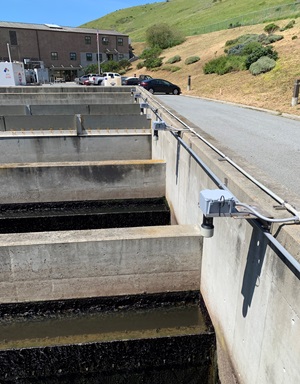Radar provides reliable level measurement for drinking water
Nothing satisfies your thirst and is better for you on a hot summer day like an ice cold glass of water. But have you ever really thought about how that water makes it into your glass so clean? Our drinking water goes through a number of steps before it comes out of the tap, and one of the final stages in that process is the filtration stage. There are a number of ways to filter water, and a small coastal municipality in northern California uses sand filtration bays.
How filtration works
Filtration bays work by pumping water in from above, and the water slowly trickles through layers of sand below. As the water moves through the four to eight feet of sand, any particles in the water “stick” to the sand, leaving cleaner water coming out the other side. After a certain amount of time, the sand filter needs to be cleaned, and it’s during this cleaning cycle operators drop the water level and pump air through the sand, forcing all the particles to float to the surface. After this, the water level slowly rises and the dirty water gets flushed. Then, operators refill the bay with new, influent water to start the process over again. In a single day, the water levels in these filtration bays rise and fall a number of times, and it must be done slowly and deliberately with great accuracy.
Getting reliable measurements no matter the weather
Most facilities, including this northern California municipality, use ultrasonic sensors to track the water levels’ rise and fall multiple times a day. In most municipalities across the country, filtration bays are located indoors to protect the process from outside influences, like freezing in the winter. However, freezing isn't a concern in northern California, so this municipality kept their filtration bays outside. While northern California doesn’t need to worry about freezing water, they do see their share of sunshine throughout the year as well as rain in the winter and fog in the summer – all of which can cause errors for ultrasonic devices. 
Measurement errors became routine for operators when fog rolled in or it began to rain. They needed a cost-effective solution to accurately measure the water level in all types of weather – sunshine, rain, and fog. After discussing their ongoing issue with their VEGA representative, it became clear the VEGAPULS WL S 61 would be the solution they needed. That’s because radar signals are unaffected by temperature, rain, and fog. With a price point similar to the ultrasonic transmitters they had been using, the VEGAPULS WL S 61 was the ideal, economical replacement.
Since installation, the water treatment plant has seen a lot of sunshine, a number of rain events, and its fair share of fog without a single measurement error in all that time. All five VEGAPULS WL S 61 sensors are reliably monitoring the ups and downs of the water levels in each filtration bay, giving operators the control they need for their filtration process.
Featured product:
Export this article
Download as PDFShare this article
Comments ({{comments.length}})
{{getCommentAuthor(comment, "Anonymous")}} {{comment.timestamp | date : "dd.MM.yyyy HH:mm" }}
{{comment.comment}}





